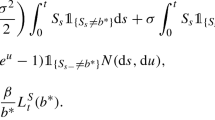Abstract
This paper focuses on historical and risk-neutral default probabilities in a structural model, when the firm assets dynamics are modeled by a double exponential jump diffusion process. Relying on the Leland [(1994a) Journal of Finance, 49, 1213–1252; (1994b) Bond prices, yield spreads, and optimal capital structure with default risk. Working paper no. 240, IBER, University of California, Berkeley] or Leland and Toft [(1996) Journal of Finance, 51(3), 987–1019] endogenous structural approaches, as formalized by Hilberink and Rogers [(2002) Finance and Stochastics, 6(2), 237–263], this article gives a coherent construction of historical default probabilities. The risk-neutral world where evolve the firm assets, modeled by a class of geometric Lévy processes, is constructed based on the Esscher measure, yielding useful and new analytical relations between historical and risk-neutral probabilities. We do a complete numerical analysis of the predictions of our framework, and compare these predictions with actual data. In particular, this new framework displays an enhanced predictive power w.r.t. current Gaussian endogenous structural models.
Similar content being viewed by others
References
Altman, E. (1968). Financial ratios, discriminant analysis and the prediction of corporate bankruptcy. Journal of Finance, 23(3), 589–609.
Black, F., & Cox, J. (1976). Valuing corporate securities: Some effects of bond indenture provisions. Journal of Finance, 31(2), 351–367.
Chen, N., & Kou, S. G. (2005). Credit spreads, optimal capital structure, and implied volatility with endogenous default and jump risk. Working paper.
Collin-Dufresne, P., & Goldstein, R. (2001). Do credit spreads reflect stationary leverage ratios. Journal of Finance, 56(5), 1929–1958.
Crouhy, M., Galai, D., & Mark, R.(2000). A comparative analysis of current credit risk models. Journal of Banking and Finance, 24, 59–117.
Dao, T. B., & Jeanblanc, M. (2005). A double exponential structural jump diffusion model with endogenous default barrier. Working paper.
Duffie, D., & Singleton, K. (1999). Modeling term structures of defaultable bonds. Review of Financial Studies, 12, 687–720.
Eom, Y. H., Helwege, S., & Huang, J. (2003). Structural models of corporate bond pricing: An empirical analysis. Review of Financial Studies, 17(2), 499–544.
Fujiwara, T., & Miyahara, Y. (2003). The minimal entropy martingale measures for geometric Lévy processes. Finance and Stochastics, 7, 509–531
Gerber, H., & Shiu, E. S. (1994). Option pricing by Esscher transforms. Transactions of the Society of Actuaries, 46(1), 99–191.
Hilberink, B., & Rogers L. (2002). Optimal capital structure and endogenous default. Finance and Stochastics, 6(2), 237–263.
Huang, J.-Z., & Huang, M. (2003). How much of the corporate-treasury yield spread is due to credit risk. Working paper.
Hull, J. C., Predescu, M., & White, A. (2005). Bond prices, default probabilities, and risk premiums. Journal of Credit Risk, 1(2), 53–60.
Jarrow, R. A., Lando, D., & Turnbull, S. M. (1997). A Markov model for the term structure of credit risk spreads. Review of Financial Studies, 10, 481–523.
Jarrow, R. A., & Protter, P. (2004). Structural versus reduced form models: A new information based perspective. Journal of Investment Management, 2(2), 1–10.
Kou, S. (2002). A jump diffusion model for option pricing. Management Science, 48, 1086–1101.
Kou, S. G., Petrella, G., & Wang, H. (2005). Pricing path dependent options with jump risk via Laplace transforms. Kyoto Economic Review, 76(1), 1–23.
Kou, S. G., & Wang, H. (2003). First passage times of a jump diffusion process. Advances in Applied Probability, 35, 504–531.
Kou, S. G., & Wang, H. (2004). Option pricing under a double exponential jump diffusion model. Management Science, 50(9), 1178–1192.
Leland, H. (1994a). Corporate debt value, bond covenants, and optimal capital structure. Journal of Finance, 49, 1213–1252.
Leland, H. (1994b). Bond prices, yield spreads, and optimal capital structure with default risk. Working paper no. 240, IBER, University of California, Berkeley.
Leland, H. (2004). Predictions of default probabilities in structural models of debt. Journal of Investment Management, 2(2), 5–20.
Leland, H., & Toft, K. (1996). Optimal capital structure, endogenous bankruptcy, and the term structure of credit spreads. Journal of Finance, 51(3), 987–1019.
Longstaff, F. A., Mithal, S., & Neis, E. (2005). Corporate yield spreads: Default risk or liquidity? New evidence from the credit default swap market. Journal of Finance, 60(5), 2213–2253.
Longstaff, F., & Schwartz, E. (1995). A simple approach to valuing risky fixed and floating rate debt. Journal of Finance, 50, 789–819.
Madan, D., Unal, H. (1998). Pricing the risks of default. The Review of Derivatives Research, 2, 121–160.
Merton, R. (1974). On the pricing of corporate debt: The risk structure of interest rates. Journal of Finance, 29, 449–470
Miyahara, Y. (2001). [Geometric Lévy Process & MEMM] pricing model and related estimation problems. Asia-Pacific Financial Markets, 8(1), 45–60.
Miyahara, Y. (2004). A note on Esscher transformed martingale measures for geometric Lévy processes. Discussion papers in Economics, Nagoya City University, No. 379, pp. 1–14.
Miyahara, Y. (2005). Martingale measures for geometric Lévy process models. Discussion papers in Economics, Nagoya City University, No. 431, pp. 1–14.
Modigliani, F., & Miller, M. (1958). The cost of capital, corporation finance and the theory of investment. American Economic Review, 48(3), 261–297.
Moody’s Investors Service (1997). Historical default rates of corporate bond issuers, 1920–1996.
Nielsen, L., Saa-Requejo, J., & Santa-Clara, P. (1993). Default risk and interest rate risk: the term structure of default spreads. Working paper.
Scherer, M. (2005). A structural credit risk model based on a jump diffusion. Working paper.
Usabel, M. (1999). Calculating multivariate ruin probabilities via Gaver-Stehfest inversion technique. Insurance: Mathematics and Economics, 25(2), 133–142.
Acknowledgments
The authors wish to thank Loïc Belze, Monique Jeanblanc, Honorine N’Dri, Rivo Randrianarivony, Marc Sardy, Philippe Spieser, and the referees, for their useful and insightful comments.
Author information
Authors and Affiliations
Corresponding author
Rights and permissions
About this article
Cite this article
Le Courtois, O., Quittard-Pinon, F. Risk-neutral and actual default probabilities with an endogenous bankruptcy jump-diffusion model. Asia-Pacific Finan Markets 13, 11–39 (2006). https://doi.org/10.1007/s10690-007-9033-1
Published:
Issue Date:
DOI: https://doi.org/10.1007/s10690-007-9033-1
Keywords
- Cumulative default probability
- Structural model
- Jump-diffusion
- Endogenous capital structure
- Esscher transform
- Kou processes




